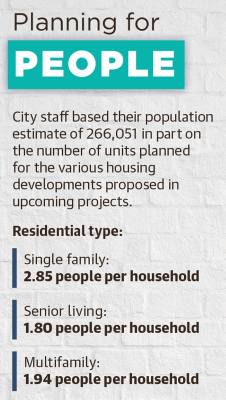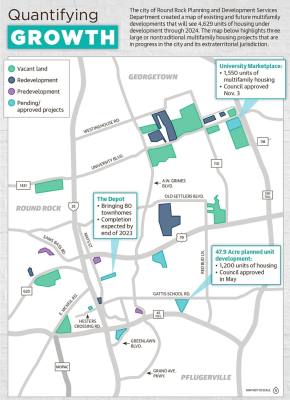Due in part to ramped up housing and other types of development, city staff are now predicting the population in the Round Rock area will surpass 265,000 by 2040. While this is not a firm build-out number, it does impact local planning for growth.
“We can’t pretend that people are not going to come here,” Round Rock Mayor Craig Morgan said during a Dec. 6 State of the City address. “They’re going to come here. We have great schools; we have a great [city and] environment.”
Although the growth projections are sparking concerns from some longtime Round Rock residents, developers and city officials are adapting housing strategies to accommodate the projected influx. One strategy involves incorporating options beyond single-family homes as outlined in an August report from the Round Rock Planning and Development Services Department.
To that end, in recent months the approval of several multifamily housing developments will bring several thousand units to Round Rock by 2024, and city leaders are anticipating the approval of thousands more in the coming years.
“It’s a very in-demand place to be,” said Brad Wiseman, Round Rock Planning and Development Services director. “Developers will see the market demand, and they will provide the housing necessary to accommodate where things are moving.”Growing density
Wiseman said the city updates its population projections on a regular basis, and it is common for a city’s “full build-out” population to fluctuate as developers change the density of their projects or pursue redevelopment.
Additionally, he said developers are shifting from building single-family homes as a response to recent interest rate increases.
“As we’ve seen a huge demand for housing, and with the cost of single-family [homes] and interest rates, apartment development is very hot,” Wiseman said.
In November and December, city officials approved more than 2,400 multifamily housing units via rezoning requests. Put into perspective, that represented about 18% of the city’s 13,436 multifamily units as of October 2022.
One development approved Nov. 3 will bring up to 1,550 units to a property located at the corner of University Boulevard and CR 118. Near University Boulevard and CR 110, a smaller townhouse and multifamily development approved Nov. 17 will create 600 units of housing. City Council also approved a 276-unit mixed-use development Dec. 1 west of I-35 on Hesters Crossing Road.
The influx of new multifamily developments has given some residents pause, as they say they have subsequent concerns around cost of living, density and traffic that can often accompany spikes in development.
The most direct cause of such growth is new people moving to the area, like Serena Guin did several decades ago. When Guin first moved to Round Rock in the late 1970s, she said she did so for the high-quality schools and affordability.
Guin said she worries about the ability of longtime residents to remain in the area as the cost of living increases.
Even natives of the city are experiencing difficulties amid what are ostensibly prosperous times in the city. Ella Sauls Morrison has lived in the Round Rock area for several decades and said she fears the rising cost of living has led some older, longtime residents on fixed incomes to seek new homes elsewhere.
“New development is catered to people who can afford it,” Sauls Morrison said. “What about the rest of us?”
With new residents moving in, many of the existing roadways have become more crowded, especially in areas of town serviced by two-lane arterials.
Christine Gonzales, who lives in a community off of Red Bud Lane in northeast Round Rock, said she is concerned about safety on the two-lane road as development in her area expands. She suggested additional traffic control measures and widening the road, which is included in the city’s Transportation Master Plan.
“[Red Bud Lane] has always been used as a bypass, but it’s becoming more and more popular now,” Gonzales said. “I don’t even know where it’s possible to widen roads anymore.”
School district planning
Planning for additional housing is moving at a fast pace for city leaders and developers, but Terry Worcester, Round Rock ISD’s chief operating officer, said growth projections are not as urgent for RRISD regarding enrollment considerations.
The district is constantly engaged in planning for growth within its district, but planning for the student population of a school district is slightly different than the way a city might plan for its population, Worcester said.
The district typically views multifamily housing as “low-yield” as far as the number of school-aged children who may live there, unless it is geared toward families with multibedroom apartments, he said.
Additionally, Worcester said population estimates, such as those prepared by the city, go a long way in planning for the district, but they may not prompt immediate action, such as a bond to fund new campuses.
Campuses needing additional capacity have multiple ways of adding room for new students before making such large investments, he said.
“These large-scale developments happen fairly slowly,” Worcester said. “The district has to be mindful that it’s like the tortoise—it’s going to move along at a steady pace.”
Expanding downtown
A key element to planning for the city’s growth is the Round Rock 2030 Comprehensive Plan.
A major goal outlined in the Round Rock 2030 Comprehensive Plan, which details much of the population growth planning underway in the city, is the construction of 1,000 additional housing units within a quarter-mile of downtown to enhance walkability.
To accomplish this, City Council has approved multiple multifamily developments in the downtown area, with one project under construction called The Depot.
Located behind City Hall and north of the Union Pacific Railroad tracks, The Depot will bring 80 townhomes to the downtown area.
Other housing developments approved in 2022 that could bring more multifamily units to downtown include a 60-unit townhome development off of East Main Street and a 410-unit apartment complex just south of the train tracks.
The Depot is anticipated to be move-in ready by the end of 2023, but completion estimates are not yet available for the other two projects.
Round Rock’s Planning and Development Services Department has worked over the past several years to increase standards for multifamily projects, providing additional requirements, such as privacy walls and foliage when located near single-family homes. Other adaptations to standards include the outward appearance of multifamily developments for elements, such as balconies.
“I think for the longest time, multifamily kind of had a bad name,” Morgan said. “But the standards are so much different now. Back in 2011, this was a concern at the city, and we created some tiered levels of standards. I think that helps maintain their value.”









